
Kody Beler, new science communicator About 98 out of 100,000 human patients every year suffer from interstitial lung disease, a broad collection of several lung diseases that manifest as inflammation and scarring of lung tissue and a loss of lung function. Because of the invasiveness of the necessary lung biopsy, however, the diseases are often […]







